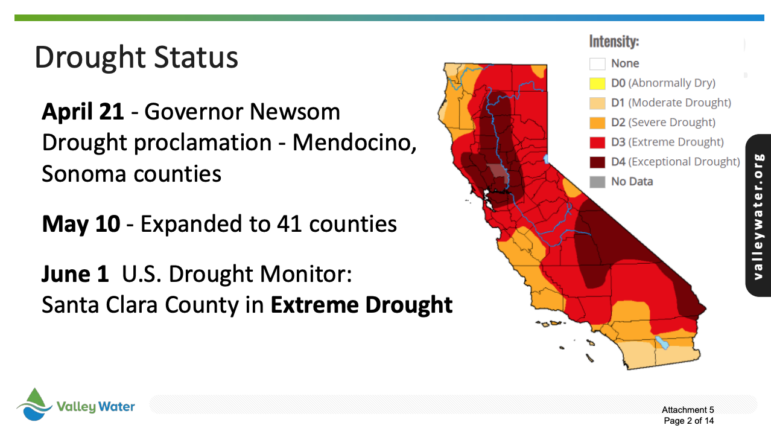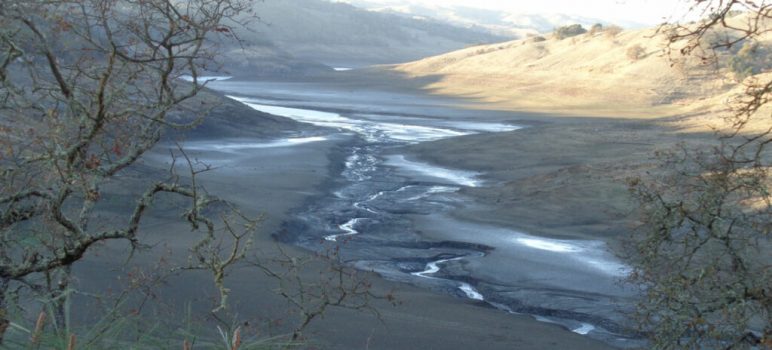Mandatory water restrictions are on their way to Santa Clara County faucets and hoses, as the area faces “extreme drought” and dismal water supplies.
The Santa Clara Valley Water District board announced a water shortage emergency in a 7-0 vote Wednesday, setting targets to reduce water use countywide by 15% of 2019 levels.
The vote recommends local water retailers and cities enact restrictions and price solutions, hoping to avoid pulling excess water from the area’s ground supply and aquifers—the first mandatory reductions since the 2012-2016 drought.
“There simply isn’t much water in this dry year,” said Aaron Baker, Valley Water District COO.“We recommend action now, because water reduction takes time to implement, and the current condition is unprecedented.”
So what does 15% less water consumption look like?
For now, South Bay residents should refrain from fretting about fewer pots of coffee during endless work cycles or sparse showers during scorching summer heat waves. Instead, the proposed drought prohibitions include limiting watering of ornamental lawns to no more than three days a week and limited private washing of cars, boats or other vehicles without shutoff-nozzle hoses.
Additionally, the water shortage may mean restaurants won’t provide glasses of water unless requested by patrons, and swimming pools will be prohibited from being to be filled or refilled.

Courtesy of Valley Water
Half of Santa Clara County’s water supply is imported from outside county lines, but even those reserves are lower. Santa Clara Valley Water District Board Vice Chairperson Gary Kremen said the reduction is needed after another very dry winter, resulting in low Sierra snow pack. Additionally, these water supply issues are exacerbated by the essentially empty Anderson Reservoir, which was drained in December 2020 for seismic retrofitting and other projects.
Kremen said surging prices have now made buying water on the open market more difficult, as everyone is feeling the supply strain. The San Jose Water Company announced it will continue monitoring its supply, but didn’t yet say whether water rates for its 1 million customers would increase due to the conservation efforts.
Since cutting residential water use isn’t going to actually address the entire water shortage, director Linda LeZotte said a minimalist mindset when folks turn their faucets is one tool to address the need.
She said Valley Water will be working on providing clearer messaging and education about what exactly a 15% reduction of water use looks like—now and in the foreseeable future.
“All of that math really means nothing to someone who’s listening,” LeZotte said. “If you follow the science, this is the new normal. Conservation is going to be a way of life.”





California gets a lot of rain seasonally. Almost NONE of it is captured for reuse. Or properly directed to replenish underground aquifers. The only water captured is the snow in the Sierras.
How about building a few more LARGE reservoirs to capture the rain and snow runoff? Oh. No. That cannot be done, because it will impede on some other environmental restriction.
Why not give directions to homeowners on how to properly direct roof runoff to replenish ground water? That seems like an easy ask….
Water rationing Oh No! Lets drain the reservoirs and fix the dams that might break next time we have too much water! Lets fine people for catching rain water in barrels. Lets ban new dam building.
By all means let shut down gas fired power plants so we can’t desalinate ocean water cheaply.
I think maybe we could run our politician through a ringer and squeeze the excise water out of them might help a bit.
CYNTHIAJR,
Yes, most water use is environmental — 50% enviro, 40% ag, 10% “urban”
“Urban” = Commercial, industrial, residential, typically in metro or urban areas
—
In addition to Sikes being built now, there are the North Coast district rivers to tap. (Some have state or federal protection, but since when do Dems care about law if it’s in their way? I have also seen some local kid just say, take the water from Alaska because there’s some water there.)
One of the easiest things and first things to look at is to raise Shasta Dam. That would be done anyway if water were to be shipped to California from anywhere north — put it into Lake Shasta to get distributed by the existing water system.
Do you possibly recall:
https://www.nytimes.com/1979/01/18/archives/us-may-add-200-feet-to-a-coast-dam-cheaper-alternative.html
It may become more of an issue to tap more Sacramento River and North Coast District water supplies later once the bypass of the Delta someday is built.
The pool you described is 547 sq. ft. A 1/4-acre lot is 10,890 sq. ft. So the pool is only around 5% of the area of the lot it’s on. If your “wit” is spread this thin, then you and several others amount to less than a halfwit. Using your logic, reservoirs should only be built where rainfall exceeds 65 inches per year.
Katy Lauren, San Jose Inside: Why in the holy f_____g hell didn’t San Jose and Santa Clara County Water Districts initiate water rationing three or more years ago??? We have been in a drought for decades. I hike and have seen all of the major reservoirs critically low for many years. Some bone dry. And why are we just now hearing anything about the situation? Not even “If it’s brown, flush it down. If it’s yellow, let it mellow.” Plus the water districts will raise prices because we are conserving, not using enough water for them to make the profit guaranteed by the City and County government. This sad and critical in so many ways. Please step up and see who all is profiting from the lack of water. Oh and just a reminder, nothing living can exist without water. Bye California.